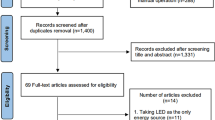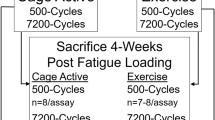Abstract
Background
Earlier studies have reported positive results from eccentric training in patients with tendon disorders. The reasons for the beneficial clinical effects of eccentric training are not known. Vascularization followed by regression of the vasculature enhances the healing response of injured tendons. Eccentric exercise induces a more beneficial healing response than concentric exercise.
Methods
Sixty rats with patellar tendon injuries were divided into three groups: nonexercise controls (group N; n = 20); concentric exercise group (group C; n = 20); eccentric exercise group (group E; n = 20). Each rat was taught to run uphill or downhill for 14 days. Patellar tendons were removed 1, 4, 7, 10, and 14 days following injury. Vascular endothelial growth factor (VEGF), angiopoietin-1, and angiopoietin-2 were measured by reverse transcription polymerase chain reaction.
Results
In group C, VEGF mRNA was increased 1 and 4 days following injury but was decreased on days 7, 10, and 14. In group E, VEGF mRNA was elevated only on day 1. In group N, VEGF mRNA remained at a low level throughout all 14 days. The angiopoietin-2/angiopoietin-1 ratio was higher for group C than for group E.
Conclusions
In the presence of VEGF, angiopoietin-1 promotes vessel stability, whereas angiopoietin-2 has the opposite effect. Eccentric exercise contributes to stabilized angiogenesis during the early phase of tendon injury. Conversely, concentric exercise, which induces destabilized angiogenesis, leads to a delayed healing response. Initiation of eccentric exercise immediately after tendon injury may help improve healing by reducing vascularity.
Similar content being viewed by others
References
Kobayashi T. Effect of cyclic tensile loading on ligament and ligament-bone junction. J. Juzen Med Soc 1997;106:236–248 (in Japanese).
Chan BP, Fu SC, Qin L, Rolf C, Chan KM. Pyridinoline in relation to ultimate stress of the patellar tendon during healing: an animal study. J Orthop Res 1998;16:597–603.
Armstrong RB, Ogilvie RW, Schwane JA. Eccentric exercise-induced injury to rat skeletal muscle. J Appl Physiol 1983;54:80–93.
Fenwick SA, Hazleman BL, Riley GP. The vasculature and its role in the damaged and healing tendon. Arthritis Res 2002;4:252–260.
Molloy T, Wang Y, Murrell G. The roles of growth factors in tendon and ligament healing. Sports Med 2003;33:381–394.
Richards HJ. Repair and healing of the divided digital flexor tendon. Injury 1980;12:1–12.
Breen EC, Johnson EC, Wagner H, Tseng HM, Sung LA, Wagner PD. Angiogenic growth factor mRNA responses in muscle to a single bout of exercise. J Appl Physiol 1996;81:355–361.
Gavin TP, Wagner PD. Effect of short-term exercise training on angiogenic growth factor gene responses in rats. J Appl Physiol 2001;90:1219–1226.
Prior BM, Yang HT, Terjung RL. What makes vessels grow with exercise training? J Appl Physiol 2004;97:1119–1128.
Carmeliet P, Ferreira V, Breier G, Pollefeyt S, Kieckens L, Gertsenstein M, et al. Abnormal blood vessel development and lethality in embryos lacking a single VEGF allele. Nature 1996; 380:435–439.
Ferrara N, Carver-Moore K, Chen H, Dowd M, Lu L, O’shea KS, et al. Heterozygous embryonic lethality induced by targeted inactivation of the VEGF gene. Nature 1996;380:439–442.
Maisonpierre PC, Suri C, Jones PF, Bartunkova S, Wiegand SJ, Radziejewski C, et al. Angiopoietin-2, a natural antagonist for Tie2 that disrupts in vivo angiogenesis. Science 1997;277:55–60.
Suri C, Jones PF, Patan S, Bartunkova S, Maisonpierre PC, Davis S, et al. Requisite role of angiopoietin-1, a ligand for the TIE2 receptor, during embryonic angiogenesis. Cell 1996;87:1171–1180.
Holash J, Maisonpierre PC, Compton D, Boland P, Alexander CR, Zagzag D, et al. Vessel cooption, regression, and growth in tumors mediated by angiopoietins and VEGF. Science 1999;284: 1994–1998.
Amadeu T, Braune A, Mandarim-de-Lacerda C, Porto LC, Desmouliere A, Costa A. Vascularization pattern in hypertrophic scars and keloids: a stereological analysis. Pathol Res Pract 2003;199:469–473.
Hurme T, Kalimo H, Lehto M, Jarvinen M. Healing of skeletal muscle injury: an ultrastructural and immunohistochemical study. Med Sci Sports Exerc 1991;23:801–810.
Cass DL, Sylvester KG, Yang EY, Crombleholme TM, Adzick NS. Myofibroblast persistence in fetal sheep wounds is associated with scar formation. J Pediatr Surg 1997;32:1017–1021.
Lee JY, Yang CC, Chao SC, Wong TW. Histopathological differential diagnosis of keloid and hypertrophic scar. Am J Dermatopathol 2004;26:379–384.
Sun Y, Weber KT. Infarct scar: a dynamic tissue. Cardiovasc Res 2000;46:250–256.
Nakamura R. Effect of eccentric and concentric exercise on tendons. J Juzen Med Soc 2003;112:19–27 (in Japanese).
Alfredson H, Pietilä T, Jonsson P, Lorentzon R. Heavy-load eccentric calf muscle training for the treatment of chronic Achilles tendinosis. Am J Sports Med 1998;26:360–366.
Lindstedt SL, LaStayo PC, Reich TE. When active muscles lengthen: properties and consequences of eccentric contractions. News Physiol Sci 2001;16:256–261.
Jensen K, Di Fabio RP. Evaluation of eccentric exercise in treatment of patellar tendinitis. Phys Ther 1989;69:211–216.
Öhberg L, Alfredson H. Effects on neovascularisation behind the good results with eccentric training in chronic mid-portion Achilles tendinosis? Knee Surg Sports Traumatol Arthrosc 2004;12: 465–470.
Mayer F, Axmann D, Horstmann T, Niess A, Striegel H, Ruf J, et al. Metabolic and cardiocirculatory reactions after concentric and eccentric exercise of the shoulder. Int J Sports Med 1999; 20:527–531.
Jones DA, Rutherford OM. Human muscle strength training: the effects of three different regimes and the nature of the resultant changes. J Physiol 1987;391:1–11.
Author information
Authors and Affiliations
About this article
Cite this article
Nakamura, K., Kitaoka, K. & Tomita, K. Effect of eccentric exercise on the healing process of injured patellar tendon in rats. J Orthop Sci 13, 371–378 (2008). https://doi.org/10.1007/s00776-008-1242-6
Received:
Accepted:
Published:
Issue Date:
DOI: https://doi.org/10.1007/s00776-008-1242-6




